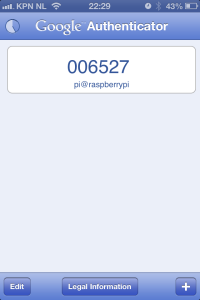The recent article on Ars Technica, Anatomy of a hack: How crackers ransack passwords like “qeadzcwrsfxv1331” made me realize again how weak password authentication is. True, in this case the MD5 hashes were known, but still it’s only a single factor. Imagine what happens when you reuse a password on multiple sites, and one of them stores it as MD5 (or SHA-1, even plain-text) and gets comprimised.
Brute-force
What’s interesting in the above article, is that brute-force attacks only work up to 6 to 7 characters (depending on the hardware available) because of the so-called “exponential wall of brute-force cracking” caused by the exponentially increasing number of guesses each additional character creates. Although project Erebus v 2.5 already demonstrated brute-forcing any 8 character password in just 12 hours with a 8 GPU cluster. This, however, does not mean a 9+ character password is safe. In fact, passwords of 16 characters are easily cracked when using the right techniques.
Patterns
One of the techniques used to crack the passwords, is to use common patterns. These patterns were learned from past security breaches. Especially the famous RockYou breach, in which they lost millions of passwords in plain-text. This revealed many passwords people use in real life and gave an interesting view on how people choose passwords. Not only are these passwords added to the word lists used to crack passwords today (500 hundred million words is no exception), patterns were developed as well to help efficient cracking of more complex longer passwords.
A simple example of such a pattern is: Winter09 (word starting with a capital, two digits added to the end, all lowercase in the middle). Don’t think ‘W1nt3r09’ is safer, as this is also a pattern: i is replaced by 1, e with 3, etc. Huge collections of patterns can be found online.
You can now imagine why you should use random password instead. Random strings are the best, because they can only be brute-forced. When you take a 12 character random password, such as 45zCpJEq8bAf, you’ll be safe. The longer, the better, but W6Bf7TwFfRhM3xQ9FYckCYs3VpY38yJR is much harder to remember, of course. Fortunately, tools exist to help you.
Password managers
Use a secure password manager to help you remember strong passwords. I say secure, because the password managers in browsers are not secure (at all). Services like 1Password and LastPass provide an encrypted vault in which you can store your passwords, protected by a secure, random master-password. They integrate in your browser, and automatically fill-in your site-specific, strong, password. This password can now be much longer, since you don’t have to remember it. All you have to remember is the master-password.
Everything is encrypted locally, before sending to their servers, making it useless data without your master-password. It’s automatically sync’ed across your devices (laptop, desktop, mobile, tablet, etc). Check it out, it’s great.

Google Authenticator
Multi-facor authentication
Now that you have safe passwords, and a way to manage them, I’d like to suggest another technique called ‘multi-factor authentication‘. Multi-factor authentication (also Two-factor authentication, TFA, T-FA or 2FA) is an approach to authentication which requires the presentation of two or more of the three authentication factors: a knowledge factor (“something the user knows”), a possession factor (“something the user has”), and an inherence factor (“something the user is”).
Both 1Password and LastPass support two-factor authentication. This can eiher be hardware device (RSA, Yubikey, etc) or software (like Google Authenticator). Sometimes verification codes are send as SMS-messages. When two-factor authentication is enabled, you need to have a master-password and a verification key to access your vault. That’s great security for your passwords!
Final thing you should do, is protect your e-mail address with two-factor authentication, as well. Some e-mail providers offer this service. Google’s Gmail even offers it for free. Why this is important? Because most sites send a ‘password lost’ e-mail to verify a password change. So your passwords are only as secure as your e-mail password. With an added security layer, this becomes much harder to crack. You now probably also understand why you shouldn’t reuse your e-mail password on other sites..
I hope this blog brings in some inspiration to upgrade your online security!





Reminds me of this little comic insight:
http://xkcd.com/936/
hehe nice! 🙂
Nice article. However note that LastPass does not locally encrypt all entries in the vault. Exceptions include the URL, field names, flags and the names of shared folders.
Cheers,
Iggi
Nice to know, thanks!